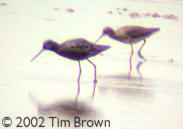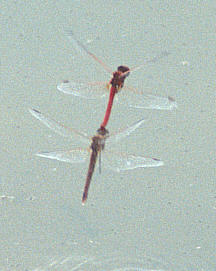
Moorhens - Leathes Ham
Great
Crested Grebe Podiceps cristatus
One was noted on the sea at Kessingland on the 26th, 27th and 28th.
Diver sp. Gaviidae
One distant bird heading north past Kessingland on the 1st was possibly
a Black-throated Gavia arctica.
Fulmar Fulmarus glacialis
Noted past Kessingland on the 6th (30), 10th-26th (1-4 per day), 28th (3),
29th (4) and 30th (72).
Manx Shearwater Puffinus puffinus
Noted past Kessingland on the 6th (3), 24th (1) and 28th (3). All were
singletons moving north.
Gannet Morus bassanus
Noted past Kessingland on the 6th (75), 17th (36), 19th (49), 24th (48),
25th (134, 129 N, 5 S), 26th (89, 84 N and 5 S), 28th (116, 108 N and 8
S), 29th (232, 224 N and 8 S) and 30th (153 N). On the 25th some were feeding
at distance, with dives from approximately 7-10 metres.
European
Shag Phalacrocorax aristotelis
Two roosted in dead trees at Leathes Ham from the 26th-30th, along with
up to twelve Cormorants P. carbo. They appear to have got fed up
with fighting the Kittiwakes Rissa tridactyla for a space on the
wall in the harbour each evening.
 Little Egret Egretta garzetta One was frequenting ditches and the mudflats at Burgh Castle on the 23rd, a distant shot of it in flight appears to the left. (Videograb: Tim Brown). |
Grey
Heron Ardea cinerea
Two flew south past Kessingland on the 22nd with one north on the 25th.
Spoonbill Platalea leucorodia
Three flew south past Kessingland at 17:00 on the 22nd 400 metres offshore.
Egyptian Goose Alopochen aegyptiacus
A flock of eighteen were feeding on the mudflats at Burgh Castle on
the 23rd. This species is mainly a grazer of vegetation but in this case
seemed to be emulating the local Shelduck Tadorna tadorna feeding
habits, they were staying on the most recently exposed mud near the waters
edge where there was no sign of any algae for them to eat and were presumably
feeding on the same molluscs and crustacea that the Shelduck normally feed
on. Unlike the Shelduck though they did not sweep their bills from side
to side through the mud.
Barnacle Goose Branta leucopsis
Twenty were at Lound Waterworks on the 29th.
Brent Goose Branta bernicla bernicla
A single bird flew south at Kessingland on the 8th.
Gadwall Anas strepera
Noted south past Kessingland on the 4th (3), 17th (3) and 18th (6).
Teal A. crecca
Noted south past Kessingland on the 30th (8).
Common Scoter Melanitta nigra
Noted at Kessingland every day, with the exception of the 1st, 17th and
29th. The peak count took place on the 10th (74 north). On the 4th a flock
of 25 were on the sea with 45 south on the 21st and 43 north on the 30th.
Red-breasted
Merganser Mergus serrator
One flew north past Kessingland on the 7th.
Hobby Falco subbuteo
Noted at Lound Waterworks on the 9th (hawking insects); Lake Lothing on
the evening of the 27th; and Kessingland Beach on the 29th (hunting martins).
Avocet Recurvirostra avosetta
Noted past Kessingland on the 7th (2 south), 19th (2 south) and 20th (2
north). Elsewhere, two were feeding on the mudflats at Burgh Castle on the
23rd.
Curlew Numenius
arquata
The normal southerly movement of what are probably failed breeders was observed
at Kessingland on the 4th and then every day from the 6th -30th. Highest
counts occurred on the 16th (17), 17th (42), 22nd (30), 26th (22), 29th
(29) and 30th (32).
Whimbrel N. phaeopus
Noted south past Kessingland on the 29th (2) and 30th (4).
 Spotted
Redshank Tringa erythropus Spotted
Redshank Tringa erythropus An immaculate breeding plumaged bird was feeding with large numbers of Redshank T. totanus at Burgh Castle Flats on the 23rd. To the left is a picture of it feeding with a Redshank to its right. |
Arctic
Skua Stercorarius parasiticus
Noted past Kessingland on the morning of the 8th and at 14:40 on the 30th
when a pale morph second-summer type individual flew north. This was the
38th consecutive month skuas have been seen at Kessingland.
Skua sp. S. sp.
A small skua that flew south past Kessingland on the 10th seems likely
to have been a Long-tailed Skua S. longicaudus. The bird appeared
dark overall but not black. The most obvious feature was a white collar
(complete behind a dark cap) with no suspicion of a pale belly. There were
no obvious wing flashes however there was slight variation in tone across
the mantle and wing coverts. The wings appeared quite long and narrow with
the rear body appearing attenuated. The flight was lighter with a more relaxed
manner than typical Arctic's. Very small numbers of immature Long-tailed
Skuas are noted off southern Scandinavia between June and August (Skuas
& Jaegers: Klaus Malling Olsen & Hans Larsson: Pica Press 1997),
so perhaps we should keep a look out for them here in the southern North
Sea at this time of year.
Mediterranean Gull Larus melanocephalus
Noted past Kessingland on the 2nd (2 ad's N), 4th (2 ad's N + 1, 1st sum
S), 6th (1st sum S) and 20th (1st sum S).
Sandwich Tern Sterna sandvicensis
Noted every day of the month off Kessingland. The two highest daily totals
occurred on 13th (13 S) and 19th (14 S). Three flew north past Lowestoft
North Denes on the 28th.
'Commic' Tern sp. Sterna
Noted every day of the month off Kessingland with an inexplicable 77 north
(and 2 S) on the 6th, during three watches totalling four hours. The second
highest count concerned 8 north on the 19th.
Little Tern S. albifrons
Other than the 23rd, noted every day past Kessingland.
Guillemot Uria aalge
One flew south past Lowestoft North Denes on the 28th.
Auk sp. Alcidae
Noted past Kessingland on the 1st (5 N), 4th (1), 6th (2), 7th (2), 8th
(6), 13th (1 S), 21st, 20th (3 N), 27th (2 N), 28th (9 N), 29th (7N) and
30th (3 N).
Little Owl Athene
noctua
One was seen at Lound Waterworks on the 29th and 30th.
Common Kingfisher Alcedo atthis
One or two are regularly visiting Leathes Ham.
Blue-headed Wagtail Motacilla flava flava
A smart male which came to bathe in the pool at Corton Sewage Works on the
30th seems highly likely to be breeding locally.
Yellow Wagtail Motacilla flava flavissima
One was drinking at the pool at Corton Sewage Works on the 29th.
 Black
Redstart Phoenicuros ochruros Black
Redstart Phoenicuros ochrurosSinging males were noted around Lowestoft Harbour (2) and along Lake Lothing (1) on the 8th. There are usually around five breeding pairs in Lowestoft each year, though some are probably overlooked. The photo to the left dates from 1950 and was taken in Whapload Road. Check the Lowestoft Gallery page or click on the picture to view a larger version. |
Wheatear
Oenanthe oenanthe
One was on Kessingland Beach on the 9th.
Common Starling Sturnus vulgaris
Several thousand were roosting each evening in trees along Lake Lothing.
In winter they favour the Harbour.
Still no pink ones though!!!
